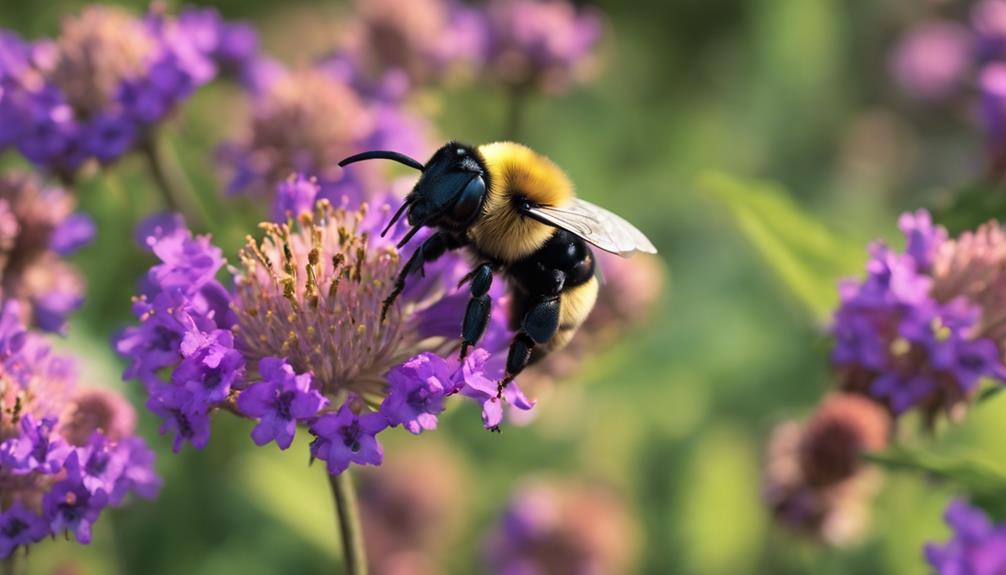Making a bee smoker at home involves gathering a few essential materials and following a simple process. You’ll need items like a metal can or tin, a small bottle or jar, metal wire or a coat hanger, and a piece of leather or cloth for a secure connection. Clean and prepare the metal can first to ensure it’s safe for handling. Construct the fire chamber by creating an opening strip and connecting it to the bellows to emphasize the importance of smoke generation. It’s essential to light the fuel using dry, flammable materials, ensuring proper airflow and consistency in the flame for effective beekeeping. Seal the can securely to prevent smoke leakage, creating a calming environment for the bees. Once the bee smoker is ignited, puff gently for consistent smoke, ensuring a smooth beekeeping experience. Mastering the construction and usage of a bee smoker is crucial for beekeepers to handle hives with ease and safety.
Main Points
- Prepare a sturdy metal can for the fire chamber.
- Construct a well-built fire chamber for efficient smoke generation.
- Use dry, flammable materials to ignite the smoker.
- Properly seal the canister to control smoke flow.
- Ignite the smoker with even ignition and monitor for consistent smoke.
Materials Needed
To make a bee smoker at home, we’ll need a metal can or tin, a small bottle or jar, metal wire or coat hanger, and a piece of leather or cloth.
The metal can acts as the crucial body of our smoker, while the bottle or jar functions as the bellows to keep the smoke going.
Using the metal wire or coat hanger, we can fashion a secure handle for easy handling.
The final touch is the piece of leather or cloth that seals the connection between the can and bottle, ensuring a critical fit.
Remember, a secure connection is essential for the smoker to work effectively and keep those bees calm.
With these basic materials, we’re all set to create our homemade bee smoker!
Prepare the Metal Can
After choosing a suitable metal can for our bee smoker, the next step is to prepare it for assembly. Here are some tips to make sure our metal can is ready to become the heart of our beekeeping tool:
- Clean Thoroughly: Wash the can with soap and water to eliminate any dirt or debris that could impact the bee smoker’s functionality.
- Remove Labels: Peel off any stickers or tags on the can to prevent unwanted substances from burning and potentially harming the bees.
- Check for Sturdiness: Verify that the can is strong enough to withstand the heat of the burning fuel and smoke without warping or leaking.
- Smooth Surfaces: Ensure there are no sharp edges or rough spots on the can that could present a safety hazard while handling the bee smoker.
Construct the Fire Chamber

Now, let’s move on to constructing the fire chamber for our homemade bee smoker. When creating the fire chamber, remember it plays an important role in generating the smoke beekeepers use.
Start by cutting a 1-inch strip from the top of the bottle to form the opening. This strip will serve as a handle for easy access to add fuel and light it up. Making sure the opening is wide enough for smooth operation.
Securing the fire chamber to the bellows is essential to prevent any smoke leaks during use. A well-built fire chamber is necessary for efficient smoke production and control in your bee smoker.
Taking the time to construct it properly will pay off when you’re out tending to your bees.
Light the Fuel
Let’s ignite the fuel in the bee smoker using a match or lighter to guarantee even combustion. When lighting the smoker fuel, it’s important to create a steady burn for effective beekeeping.
Here are some tips to ensure a successful ignition:
- Use dry and flammable materials like cardboard, paper, or wood shavings for easy lighting.
- Avoid materials that produce toxic fumes, keeping your bees safe and honey uncontaminated.
- Maintain proper airflow through the smoker’s bellows to regulate the burn.
- Monitor the flame to prevent overheating and maintain a consistent smoke output for calming bees.
Seal the Can Properly

To guarantee peak functionality of the bee smoker, it’s vital to correctly seal the canister or bottle to prevent smoke leakage. Close the lid tightly to make sure that the smoke remains inside the smoker and is directed where you want it.
A well-sealed bee smoker not only helps smoke the area effectively but also prevents unnecessary smoke from escaping, allowing you to work with just the right amount of smoke. By sealing the can properly, you can control the flow of smoke, creating a calming environment for the bees without overwhelming them.
This step is essential for maintaining a balance between creating enough smoke to keep the bees calm and ensuring that there’s little smoke wastage.
Ignite the Smoker
We start the smoker by lighting the fuel in the chamber using a match or lighter until it ignites. To guarantee a smooth beekeeping experience, follow these tips:
- Use the Right Materials: Opt for dry, combustible materials like cardboard, pine needles, or wood shavings for efficient burning.
- Even Ignition: Make sure the fuel is lit evenly to produce a steady stream of cool smoke that won’t harm the bees.
- Puff Gently: When lighting the smoker, gently puff the bellows to maintain a consistent smoke output without overwhelming the hive.
- Monitor Continuously: Keep an eye on the smoker throughout your beekeeping operations to ensure it stays lit and continues producing the desired cool smoke.
Manage Smoke Levels

When managing smoke levels in your bee smoker, it’s important to control the intensity wisely, ensuring it calms the bees without causing distress.
Carefully monitoring the airflow and adjusting the fuel placement are key aspects to keep in mind.
Control Smoke Intensity
Adjust the smoker’s bellows to regulate airflow and oxygen supply, effectively managing the intensity of smoke for calming bees during hive inspections. In terms of controlling smoke intensity, we’ve got you covered with some simple steps:
- Increase Vigorous Pumping: Pump the bellows more vigorously to produce denser smoke, ideal for calming bees.
- Decrease Bellows Action: Ease up on the bellows to reduce smoke intensity, offering a lighter option that still disrupts bee communication gently.
- Monitor Carefully: Keep a close eye on the smoke levels to make sure they remain at the right balance for calming the bees effectively.
- Find the Sweet Spot: Practice adjusting the smoker’s smoke intensity to strike the perfect balance, calming the bees without causing unnecessary distress.
Monitor Airflow Carefully
Monitoring airflow carefully is essential for effectively managing smoke levels when using a bee smoker. By adjusting the smoker’s bellow, you can control how much smoke is produced and where it goes. Regulating the air intake guarantees the fire burns steadily without suffocating.
If needed, direct the smoke by adjusting the nozzle towards hive frames or the hive entrance for a calming effect. Wind conditions play a role too, so keep an eye out to prevent smoke from dissipating too quickly or blowing back.
Balancing smoke levels is vital to keep the bees calm without overwhelming them. Remember, a well-managed airflow leads to a harmonious beekeeping experience.
Adjust Fuel Placement
To manage smoke levels effectively in a bee smoker, ensuring a consistent flow can be achieved by strategically placing the fuel at the bottom of the smoker. When adjusting fuel placement for ideal smoke control, consider the following:
- Control Smoke Intensity: Adding more fuel can increase smoke output, while reducing fuel can decrease smoke levels as needed.
- Regulate Smoke Production: Properly managing fuel placement allows beekeepers to regulate smoke production for different beekeeping tasks.
- Experiment with Placement: Trying out different fuel amounts and placements can help find the right balance for calming bees during hive inspections.
- Lessen Alarm Pheromone Release: By placing the fuel at the bottom, bees are less likely to detect the alarm pheromone, promoting a more relaxed hive environment.
Maintenance and Adjustments

Regular maintenance is essential for ensuring the peak performance of your homemade bee smoker. To maintain the best smoke production, make it a habit to clean the smoker regularly to prevent the buildup of soot and debris.
Check the bellows for wear and tear, replacing them when necessary to keep the airflow efficient. A well-insulated fire chamber is key to preventing heat loss and ensuring consistent smoke output.
Adjusting the airflow is important; control the compression of the bellows to regulate the intensity of smoke as needed. Having spare parts on hand is wise to quickly address any issues that may arise.

Roger Thomas is a seasoned beekeeper and hive architect with a deep-seated passion for sustainable living. His fascination with bees has shaped his professional career, giving him practical and theoretical expertise in bee behavior, colony health, and optimal hive conditions. Roger’s technical skills shine in his bespoke hive creations that cater to the specific needs of diverse bee species, while his sustainable practices promote environmental balance and the wellbeing of the bee population.
As he continues his journey in beekeeping, Roger has become a dedicated advocate for responsible practices and an insightful educator in his field. His posts aim to inspire new beekeepers, underline the importance of sustainability, and showcase the remarkable contribution bees make to our ecosystem. Roger invites you to join him as he delves into the world of bees and the rewarding, honey-sweet art of beekeeping.


